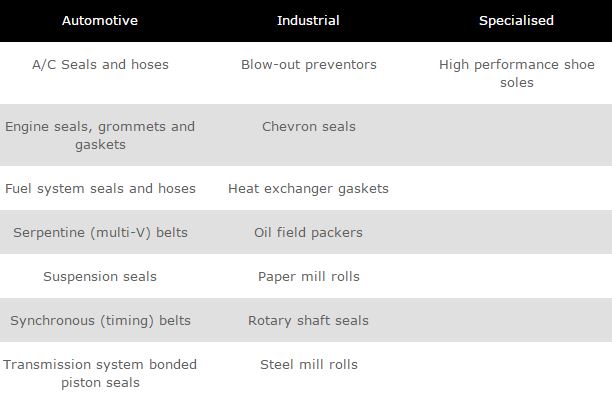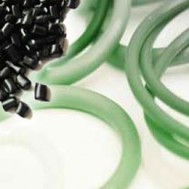When high temperature conditions require high tensile strength and resistance, one elastomer comes to mind: Hydrogenated Nitrile Butadiene Rubber (HNBR).
HNBR elastomers are changing the game for sealing and manufacturing companies. Made from hydrogenating acrylonitrile butadiene rubber (NBR), the compound meets higher temperatures, retains better resistance and has become widely known for its physical strength.
We spoke with John Tranquilli on its properties, capabilities and the applications it’s used in today.
Apple Rubber Testing: Physical properties of HNBR
HNBR results in higher strength, heat and oil resistance, and better ozone resistance—all due to its polymer structure.
“NBR polymers are filled with double and triple bonds in the polymer chain,” Tranquilli explained. “The bonds are broken and replaced with hydrogen, and result in a high-performance material.”
With NBR there is a range of Acrylonitrile (ACN) used to give higher or lower resistance to oil. Low temperature HNBR uses 17% ACN. Like NBR, fluid and chemical resistance improves as the ACN content is increased. The lower ACN, the better the low-temperature performance.
Apple Rubber has multiple formulations for low-temperature HNBR compounds, and constantly tests at low temperature.
Two quality compounds for us are 01ZT7AP and 03ZT9AP—70 and 90 Shore A black compounds. Recently, we sent our 03ZT9AP out for physical testing at low temperature. All samples were tested to ASTM D412, Die C dumbbells at a rate of 20 in./min after 10 minutes of conditions at temperature.
Below are those results:
Table 1: Physical Properties 03ZT9AP at Temperature
| Tensile | Elongation | 50% Modulus | 100% Modulus | ||
| °F | (PSI) | (%) | (PSI) | (PSI) | |
| 0 | 3790 | 158 | 1926 | 3143 | |
| -10 | 4186 | 146 | 2620 | 3688 | |
| -20 | 4259 | 112 | 3398 | 4128 | |
| -30 | 4750 | 96 | 4533 | ||
| -40 | 5097 | 58 |
From the test data, this shows that even at the low temperatures the material still shows flexibility.
HNBR Benefits
-High mechanical strength
-Excellent heat and oxidation stability
-Resistance to modern oils, fuels and coolants
-Improved wear resistance
-Temperature range from -60°C to +160°C
HNBR: Applying to the industry
HNBR has opened up a wider range of possible applications than classic NBR materials–like automotive, industrial and other performance-demanding applications.
“With the combination of physical and chemical properties, plus high performance at low temperature, this material is a great choice for under-the-hood applications,” notes John Tranquilli, materials manager. “It’s also ideal for environmental housing seals with oil exposure and O-Rings for equipment exposed to extreme environments.”
Below are common uses of HNBR:

Automotive: As the automotive industry is making ever-stricter demands to improve reliability and performance, new grades of HNBR materials allow an extended service temperature range in dynamic and static seals, hoses and belts. HNBR is on its way to replacing the polychloroprene in automotive timing belts, and they currently account for more than 50% of HNBR use in Europe.
Oil and Gas: HNBR has been widely employed for oil field exploration and processions as well as rolls for steel and paper mills.
Medical: With improved steam and chemical resistance, HNBR is an ideal choice for sanitary gaskets. Many applications currently have standard NBR compounds that give reduced shelf-life performance, where HNBR would be an appropriate solution.
“Customers today are switching from NBR to HNBR because of the improved physical properties and the extended service life of the HNBR,” noted Tranquilli. “These rubber parts will last longer in applications and even last longer in storage.”
Questions? Comments? Share your thoughts with us on Twitter @AppleRubber.
